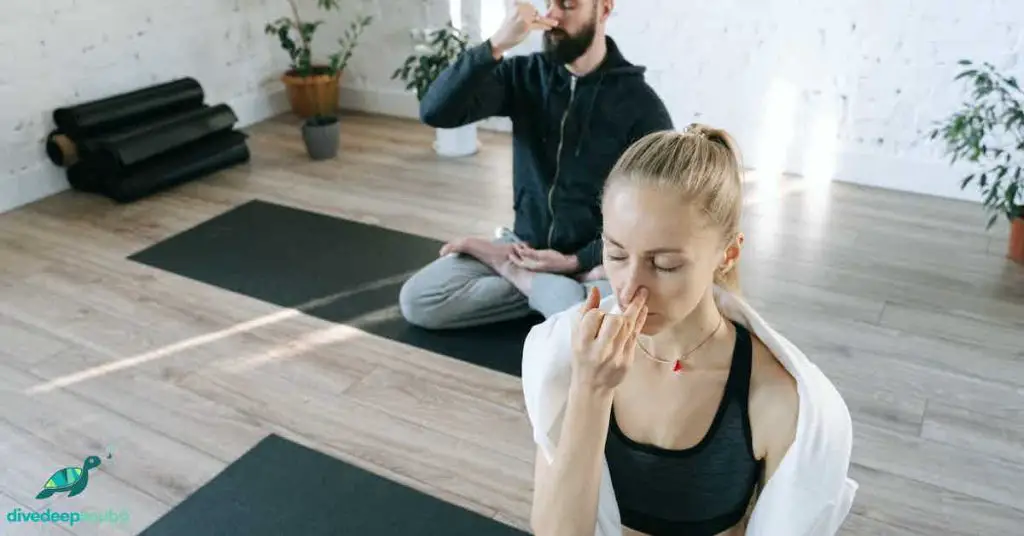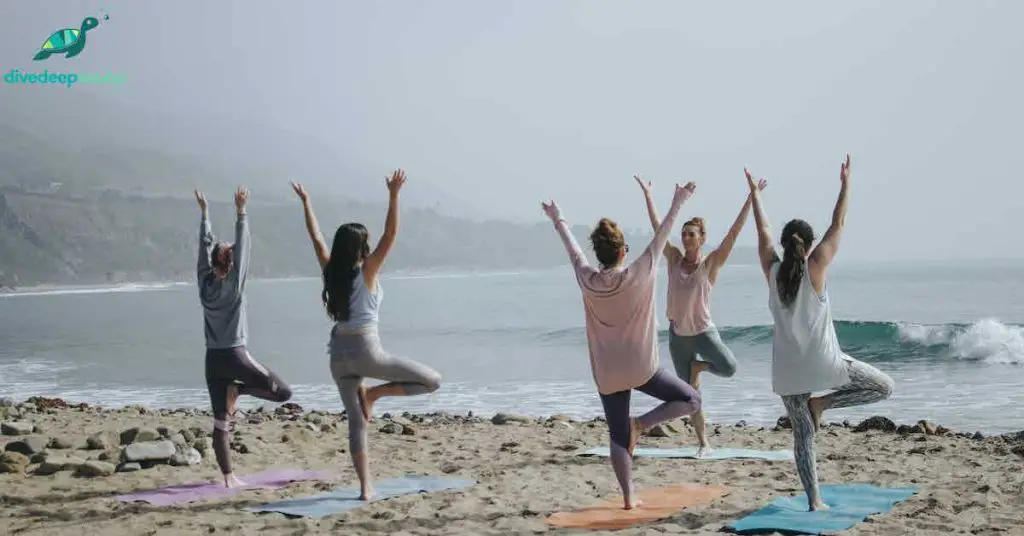How Do Freedivers Train?
Freediving includes physically training in the water, yoga and breathing exercises on land, understanding carbon dioxide and oxygen tables, and maintaining a healthy lifestyle through fitness. Freedivers go through many different training methods to reach their goals!
Freediving is an exciting and natural way to explore the underwater world. Still, before you hit the water for your first freediving experience, there are a few ways you can train yourself both physically and mentally.
In this article, we will cover both in and out-of-the-water training:
- Mental Training
- Dry Training
- CO2 & O2 Training Tables
- General Fitness/Exercise
- Dry Walking
- Apnea Weight Training
- Yoga Training
- Pool Training
- Recovery Training
Mental Training
Relaxation is one of the most important training factors! Freedivers must be able to control their mental game, because as soon as they think they cannot hold their breath a second longer, or they cannot reach the bottom, their body will listen to their mind.
This makes mental training one of the most important factors in freediving.
Most freedivers will agree that freediving is a 90% mental sport. You can be the fittest person alive, but if your mentality is not right, then you may struggle during the dive.
During mental training, you will learn creative visualisation. This is a compelling training method, as your brain cannot distinguish between thinking about something and executing the act.
Most sports involve adrenaline, but in freediving, it is the last thing you want, therefore, mental training is important for both professional and recreational freedivers.
When visualising your dive, imagine you can see, hear, and sense yourself being completely relaxed and happy underwater. Visualise everything from your pre-dive procedure, the dive itself, and how you will feel after the dive.
Most mental training is done on the floor on a yoga mat, or on a sofa/bed.
Give it a try!
Dry Training
Dry training is simply a freediver training out of the water, to practice their breath-holding techniques. This can include Dry Static and Dynamic Apnea!
As a freediver, you must also complete some dry training. Dry training allows you to practice your breath-holding skills without the added risk of being in the water.
This can be done either by lying down or standing (Static Apnea) or walking (Dynamic Apnea).
When freedivers train in this skill, you must still be advised by a freediving instructor or dive buddy to monitor your heart rate.
As a freediver, you will wear a heart rate monitor to observe your mammalian dive reflex in action. The mammalian dive reflex is wired into our genetic makeup and is activated by immersing yourself in water and holding your breath.

Carbon Dioxide and Oxygen Training Tables
Carbon Dioxide (CO2) and Oxygen (O2) training tables help a freediver train their body to adjust to high levels of CO2 and low levels of O2 during the dive. Freedivers train using CO2 and O2 tables to establish what their maximum breath-hold time is.
Training tables are important in both scuba diving and freediving. But instead of decompression tables used in Scuba, freediving requires CO2 and O2 tables to understand how these gases are affected when holding your breath; when freediving, your CO2 levels increase and your O2 levels decrease.
I know that when science is involved it can get a little technical, so stay with me now as this next part is important.
This training method involves holding your breath eight times. Using the CO2 table, the time of your breath hold stays the same, but the recovery time between your breath holds is reduced.
The CO2 table should not exceed 50% of your maximum breath-hold time.
With an O2 table, it is the opposite; the recovery time stays the same, but you increase the duration of your breath hold. The O2 table should not exceed 80% of your maximum breath-hold time.
It is also strongly advised you do not use O2 tables in the water, as they take you close to your maximum breath-hold limits.
But wait, there’s more…
It is also important that you only use one training table a day, and ensure you allow enough recovery time between your breath-holds so that you do not over-breathe.
Not only can over-breathing defeat the object of using training tables, but it can also be dangerous.
Exercise/Fitness Training
Exercise and fitness training improves a freediver’s cardiovascular health, making freediving easier and more relaxing.
I know what you are thinking, why would I need to hit the gym or go for a morning run to be a freediver?
Now, you don’t have to be a bodybuilder or run marathons to freedive, however, staying generally fit will make freediving much easier, particularly with common issues such as relaxation and equalization.
Now, strength training may not be your favourite form of exercise, but it can be very useful, particularly if you are training to complete one or more of the eight freediving disciplines, like freediving without fins.
But, if strength training really isn’t for you, then any fitness training in a gym or playing your favourite sport, is a great way to improve your general fitness.
You can practice your breath-hold techniques during strength training and cardio to help your body adapt to anaerobic respiration. However, this must be done with someone by your side, and you should never exceed your limits.
Ignoring these rules could risk you passing out, which can be very dangerous if you use gym equipment at the time.

Dry Walking
Dry walking involves the freediver walking, taking a breath in, holding their breath every couple of steps and repeating over a set time.
I know what you’re thinking, more dry training… But completing dry training plays a large part in how you will perform in the water later on.
The simplest way freedivers train is to start walking at a fast enough pace that you need to breathe from your mouth. Take a deep breath in through your nose for four steps.
Between steps four and eight, hold your breath, and then exhale on your next four steps. This is repeated for at least 10 mins, but do not overexert yourself if your fitness level is not up to it.
Are you an advanced freediver? If so, your dry walk can be done using a maximum breath-hold, but always have an instructor or buddy by your side, and walk on soft ground like sand or grass.
If your fitness is good, then you can try the dry walking technique in the gym by running on a treadmill, or cycling on a spin bike. Even if your fitness level is good, never reach the point where you feel like you are going to pass out!
If you start to feel dizzy, slow your pace.
Breath-Hold Weight Training
While holding their breath (apnea), freedivers use weight training to adapt their muscles to work under anaerobic conditions.
Exactly as it says, breath-hold weight training involves you hitting some weights while holding your breath.
The weights can be free weights or with the aid of a machine, but whichever weight training method you choose while on a breath-hold, you must have an experienced spotter with you.
Training with weights while holding your breath trains your muscles that get tired the most during a freedive like your arms and upper legs.
The more you can adapt your muscles to work under anaerobic conditions with a large lactic acid build-up, the easier and safer your dives will be.
Yoga Training and Stretching
Freedivers train via yoga and stretching to increase strength, flexibility, and body awareness, which are all beneficial to freediving.
Yoga strengthens your muscles in your arms, back, legs, and core, improves your flexibility, and makes you more aware of how your body moves.
While performing yoga poses, you shouldn’t hold your breath. However, there is a subsection of yoga called the “Pranayama”, which involves certain positions with a breath-hold, but you must be assisted by an experienced instructor that can correct your posture.
If you have tried yoga, and it isn’t for you, then you can focus on regular stretching exercises when your muscles are warmed up.

Pool Training
Freedivers need to train in a pool to practice static apnea. Static apnea involves lying face down in the water (with an instructor present) on a breath-hold. This part of training helps the freediver improve their breath-hold time in a safe environment.
Finally, we are onto some wet freedive training!
Now it is time to hop in the pool and practice your static apnea. Static apnea is beneficial for all the eight freediving disciplines, just make sure you practice them with an instructor or experienced dive buddy.
When completing any water-based training, even if it is practising your breath hold in the bath at home, never do it by yourself. Always have an experienced freediver or instructor with you at all times.
If you have jumped in the pool and your dive buddy or instructor is busy, then you can work on your fitness by swimming lengths while reducing the amount of O2 you breathe between strokes.
This trains your body to cope with higher levels of CO2 and lactic acid build-up.
But, just like dry walking, never exceed your limits! Always stop immediately if you start to feel dizzy. If you wish to swim under the water, then you must have a buddy or instructor nearby.
Recovery Training
Recovery training allows the freediver’s muscles to recover from physical freedive training. Recovery includes enough sleep, plentiful eating and drinking, and allowing enough downtime to do what they love outside the hobby.
As you will soon learn (if you haven’t already) training for freediving makes your muscles work hard, usually without oxygen, as you will be holding your breath.
Under anaerobic conditions, your body produces many waste products and free radicals, which is why you must drink lots of water and eat foods containing plenty of antioxidants after the dive.
You must also remember to rest!
Ensuring you rest during recovery training means you will not burn out and easily get sick. This includes at least eight hours of sleep during the night and finding other hobbies that make you happy.
When freedivers train, it should always be a pleasurable experience, so make sure you allow yourself enough downtime so that you will be ready for your next freediving experience!
Don’t Forget Your Dive Insurance!
Before you go out on any dive trip or holiday, it is essential to make sure you have insurance that covers you if something goes wrong. Check out our dive insurance article for more information.
Or go straight to these dive insurance company websites:
If you liked this article, please follow us on Instagram, Twitter and like our Facebook page
Final Thoughts
A freediver’s goal is to make new records, whether it be a world record as a professional freediver, or a personal best when recreationally freediving.
Training for recreational freediving isn’t limited to only water training, it involves training your fitness and breathing techniques for a safer and more enjoyable dive.
Remember that when performing any form of freediving training, you must work with an instructor that can tailor to your abilities, and help you achieve your goals safely.
Please share this article using the social media buttons!
